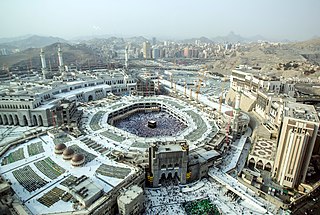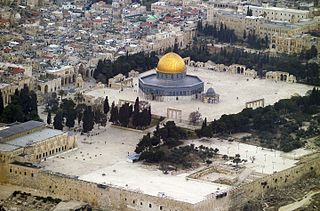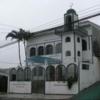A mosque, also called a masjid, is a place of worship for Muslims. The term usually refers to a covered building, but can be any place where Islamic prayers are performed, such as an outdoor courtyard.

Mecca is the capital of Mecca Province in the Hejaz region of western Saudi Arabia and the holiest city in Islam. It is 70 km (43 mi) inland from Jeddah on the Red Sea, in a narrow valley 277 m (909 ft) above sea level. Its last recorded population was 2,385,509 in 2022. Its metropolitan population in 2022 is 2.4 million, making it the third-most populated city in Saudi Arabia after Riyadh and Jeddah. Around 44.5% of the population are Saudi citizens and around 55.5% are foreigners from other Muslim countries. Pilgrims more than triple the population number every year during the Ḥajj pilgrimage, observed in the twelfth Hijri month of Dhūl-Ḥijjah. With over 10.8 million international visitors in 2023, Mecca was one of the 10 most visited cities in the world.

The Temple Mount, also known as Haram al-Sharif, al-Aqsa Mosque compound, or simply al-Aqsa, and sometimes as Jerusalem's holyesplanade, is a hill in the Old City of Jerusalem that has been venerated as a holy site for thousands of years, including in Judaism, Christianity and Islam.

The Aqsa Mosque, also known as the Qibli Mosque or Qibli Chapel, is the main congregational mosque or prayer hall in the Al-Aqsa mosque compound in the Old City of Jerusalem. In some sources the building is also named al-Masjid al-Aqṣā, but this name primarily applies to the whole compound in which the building sits, which is itself also known as "Al-Aqsa Mosque". The wider compound is known as Al-Aqsa or Al-Aqsa mosque compound, also known as al-Ḥaram al-Sharīf.

Haram is one of several similar words originating from the triliteral Semitic root Ḥ-R-M. The word literally means "sanctuary," commonly used by Muslims to refer to Al-Masjid Al-Haram and Prophet Mohammad's Mosque. There are certain rules which Muslims within these two areas must follow.

The Buraq is a magical horse-like creature in Islamic tradition that served as the mount of the Islamic prophet Muhammad during his Isra and Mi'raj journey from Mecca to Jerusalem and up through the heavens and back by night. The Buraq is also said to have transported certain prophets such as Abraham over long distances within a moment's duration.

The Israʾ and Miʿraj are the two parts of a Night Journey that Muslims believe the Islamic prophet Muhammad took during a single night around the year AD 621. Within Islam, the majority of scholars agree that the journey was both a physical and spiritual one in spite of the physics required for such a journey making it essentially impossible. A brief mention of the story is found in the 17th surah (chapter) of the Quran, called al-Isra', while details of the story are found in the hadith.

Muzdalifah is an open and level area near Mecca in the Hejazi region of Saudi Arabia that is associated with the Ḥajj ("Pilgrimage"). It lies just southeast of Mina, on the route between Mina and Arafat.

The holiest sites in Islam are predominantly located in the Arabian Peninsula and the Levant. While the significance of most places typically varies depending on the Islamic sect, there is a consensus across all mainstream branches of the religion that affirms three cities as having the highest degree of holiness, in descending order: Mecca, Medina, and Jerusalem. Mecca's Al-Masjid al-Haram, Al-Masjid an-Nabawi in Medina and Al-Masjid al-Aqsa in Jerusalem are all revered by Muslims as sites of great importance.

The Great Mosque of Kufa, or Masjid al-Kufa, is located in Kufa, Iraq and is one of the earliest surviving mosques in the world. The mosque, built in the 7th century, was home to Ali ibn Abi Talib, the 4th Rashidun caliph; and contains the shrine of Muslim ibn Aqeel, his companion Hani ibn Urwa, and the revolutionary, Al-Mukhtar. The mosque has been significantly rebuilt and restored multiple times in its history.

The Kaaba, sometimes referred to as al-Ka'ba al-Musharrafa, is a stone building at the center of Islam's most important mosque and holiest site, the Masjid al-Haram in Mecca, Saudi Arabia. It is considered by Muslims to be the Bayt Allah and is the qibla for Muslims around the world. The current structure was built after the original building was damaged by fire during the siege of Mecca by Umayyads in 683 AD.

Both Sunni Muslims and Shia Muslims agree on the three holiest sites in Islam being, respectively, the Masjid al-Haram, in Mecca; the Al-Masjid an-Nabawi, in Medina; and the Al-Masjid al-Aqsa, in Jerusalem.

Both Sunni Muslims and Shia Muslims agree on the three Holiest sites in Islam being, respectively, the Masjid al-Haram, in Mecca; the Al-Masjid an-Nabawi, in Medina; and Al-Masjid al-Aqsa, in Jerusalem.

Lists of mosques cover mosques, places of worship for Muslims. The lists include the most famous, largest and oldest mosques, and mosques mentioned in the Quran, as well as lists of mosques in each region and country of the world. The major regions, Africa, Americas, Asia, Europe and Oceania are sorted alphabetically. The sub-regions, such as Northeast and Northwest Africa in Africa, and Arabia and South Asia in Asia, are sorted by the dates in which their first mosques were reportedly established, more or less, barring those that are mentioned by name in the Quran.

The Islamization of Jerusalem refers to the process through which Jerusalem and its Old City acquired an Islamic character and, eventually, a significant Muslim presence. The foundation for Jerusalem's Islamization was laid by the Muslim conquest of the Levant, and began shortly after the city was besieged and captured in 638 CE by the Rashidun Caliphate under Umar ibn al-Khattab, the second Rashidun caliph. The second wave of Islamization occurred after the fall of the Kingdom of Jerusalem, a Christian state that was established after the First Crusade, at the Battle of Hattin in 1187. The eventual fall of the Crusader states by 1291 led to a period of almost-uninterrupted Muslim rule that lasted for seven centuries, and a dominant Islamic culture was consolidated in the region during the Ayyubid, Mamluk and early Ottoman periods. Beginning in the late Ottoman era, Jerusalem’s demographics turned increasingly multicultural, and regained a Jewish-majority character during the late-19th and early-20th centuries that had not been seen since the Roman period, which largely ended the Jewish presence in the region.

Masjid al-Haram, also known as the Sacred Mosque or the Great Mosque of Mecca, is considered to be the most significant mosque in Islam. It encloses the vicinity of the Kaaba in Mecca, in the Mecca Province of Saudi Arabia. It is among the pilgrimage sites associated with the Hajj, which every Muslim must perform at least once in their lives if able. It is also the main site for the performance of ʿUmrah, the lesser pilgrimage that can be undertaken any time of the year. The rites of both pilgrimages include circumambulating the Kaaba within the mosque. The Great Mosque includes other important significant sites, such as the Black Stone, the Zamzam Well, Maqam Ibrahim, and the hills of Safa and Marwa.

Al-Aqsa or al-Masjid al-Aqṣā is the compound of Islamic religious buildings that sit atop the Temple Mount, also known as the Haram al-Sharif, in the Old City of Jerusalem, including the Dome of the Rock, many mosques and prayer halls, madrasas, zawiyas, khalwas and other domes and religious structures, as well as the four encircling minarets. It is considered the third holiest site in Islam. The compound's main congregational mosque or prayer hall is variously known as Al-Aqsa Mosque, Qibli Mosque or al-Jāmiʿ al-Aqṣā, while in some sources it is also known as al-Masjid al-Aqṣā; the wider compound is sometimes known as Al-Aqsa mosque compound in order to avoid confusion.





































































































































